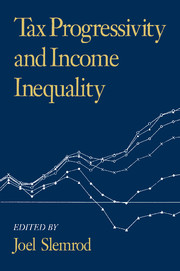Book contents
- Frontmatter
- Contents
- Preface
- List of contributors
- 1 Introduction
- 2 Trends in federal tax progressivity, 1980–93
- COMMENTS
- 3 The lifetime incidence of state and local taxes: measuring changes during the 1980s
- COMMENTS
- 4 Trends in income inequality: the impact of, and implications for, tax policy
- COMMENTS
- 5 The efficiency cost of increased progressivity
- COMMENTS
- 6 On the high-income Laffer curve
- COMMENTS
- 7 Tax progressivity and household portfolios: descriptive evidence from the Survey of Consumer Finances
- COMMENTS
- 8 Progressivity of capital gains taxation with optimal portfolio selection
- COMMENTS
- 9 Perceptions of fairness in the crucible of tax policy
- COMMENTS
- 10 Progressive taxation, equity, and tax design
- Index
4 - Trends in income inequality: the impact of, and implications for, tax policy
Published online by Cambridge University Press: 20 May 2010
- Frontmatter
- Contents
- Preface
- List of contributors
- 1 Introduction
- 2 Trends in federal tax progressivity, 1980–93
- COMMENTS
- 3 The lifetime incidence of state and local taxes: measuring changes during the 1980s
- COMMENTS
- 4 Trends in income inequality: the impact of, and implications for, tax policy
- COMMENTS
- 5 The efficiency cost of increased progressivity
- COMMENTS
- 6 On the high-income Laffer curve
- COMMENTS
- 7 Tax progressivity and household portfolios: descriptive evidence from the Survey of Consumer Finances
- COMMENTS
- 8 Progressivity of capital gains taxation with optimal portfolio selection
- COMMENTS
- 9 Perceptions of fairness in the crucible of tax policy
- COMMENTS
- 10 Progressive taxation, equity, and tax design
- Index
Summary
Introduction
In the last decade, increased public attention has been drawn to evidence that the distribution of income in the United States has become more unequal. Official Census Bureau data that in the past showed a rather stable level of inequality indicate that the level of inequality in family income reached a post-war peak in 1989 (Bureau of the Census 1989, 1992b). As a result, the 1980s have been characterized as a period where the rich became richer and the poor became poorer. The years between 1981 and 1990 have also been designated the “tax decade” (Steuerle 1992). Eight months after Ronald Reagan became president in 1981, Congress passed the Economic Recovery and Tax Act (ERTA), which dramatically lowered individual and corporate taxes. Five years later, following tax increases in 1982, 1983, and 1984, the Tax Reform Act (TRA) of 1986 became the decade's second hallmark piece of tax legislation. Although total federal, state, and local tax receipts remained relatively constant as a fraction of GNP during the 1980s (at about 26%–27%), changes in tax policy during the decade altered the way taxes were collected (Steuerle 1992). Significant reductions in marginal tax rates for the federal income tax, as well as the shift away from corporate and individual income taxes toward social security and state and local taxes, exemplify the changes that occurred during the decade.
The confluence of these two trends – one marking changes in the distribution of income across families, the other signifying shifts in the burden of taxation across families – has led some to suggest a link between changes in the tax code and the distribution of income.
- Type
- Chapter
- Information
- Tax Progressivity and Income Inequality , pp. 95 - 129Publisher: Cambridge University PressPrint publication year: 1994
- 7
- Cited by



